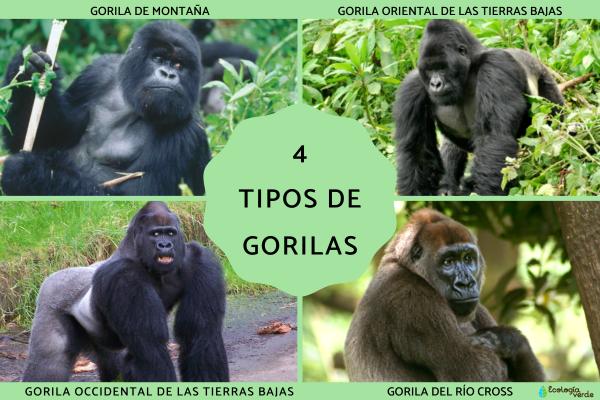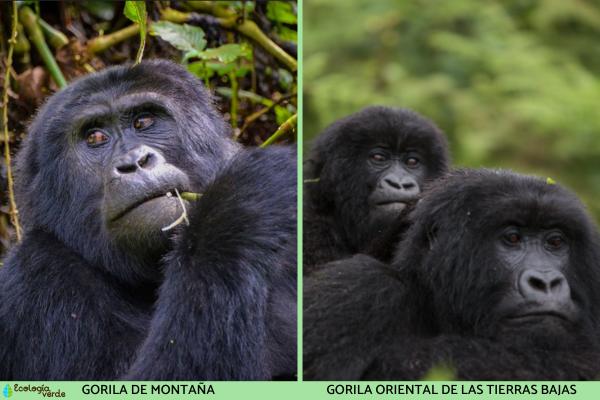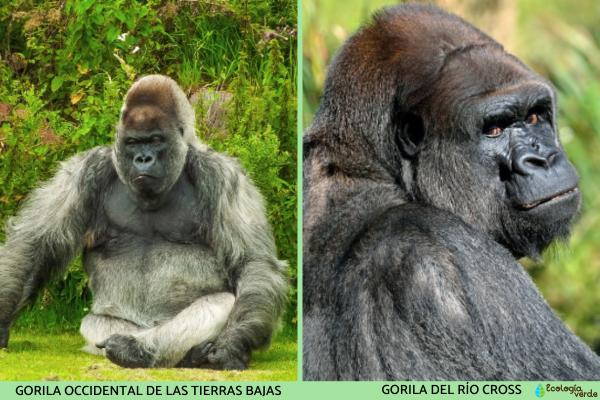According to current genetic studies, there are four types of gorillas. On one hand, there are the Eastern gorillas (Gorilla beringei), which have two subspecies: the mountain gorilla (Gorilla beringei beringei) and the Eastern lowland gorilla (Gorilla beringei graueri); on the other hand, there are the Western gorillas (Gorilla gorilla), which have two more subspecies: the Western lowland gorilla (Gorilla gorilla gorilla) and the Cross River gorilla (Gorilla gorilla diehli).

Gorillas are the largest primates alive today. They live in groups and have a strong social structure. They feed mainly on leaves and fruits and inhabit different parts of the African continent. These majestic creatures are known for their intelligence and ability to use tools. In addition, they share 98% of their DNA with humans, which makes them one of our closest living relatives.
How Many Types of Gorillas Exist?
Eastern Gorilla: Two Subspecies Explained
Western Gorilla: Two Subspecies Explained
Gorilla Conservation: Challenges and Actions
Conclusion
Modern genetic studies confirm there are two gorilla species—Eastern Gorilla (Gorilla beringei) and Western Gorilla (Gorilla gorilla)—each split into two subspecies, for a total of four types. Wild populations are dangerously low: fewer than 1,000 mountain gorillas and only around 300 Cross River gorillas remain.
The largest living primate, found in the mountainous forests of eastern Democratic Republic of Congo, northwest Rwanda, and southwest Uganda. Their diet consists mostly of leaves, stems, fruit, and occasionally insects.

Mountain Gorilla (Gorilla beringei beringei)
Found in the Virunga mountains (across Uganda, Rwanda, DRC) and Bwindi forest in Uganda. Notable for its thick, dark fur, ideal for high-altitude cold. Critically endangered due to poaching, habitat loss, and diseases shared with humans.
Eastern Lowland Gorilla (Gorilla beringei graueri) / Grauer’s Gorilla
Native to the Albertine Rift forests in eastern DRC, it is among the world’s 25 most endangered primates. More robust than western lowland gorillas, with stronger jaws and a wider torso.

Found in the lowland rainforests of western Africa. Social groups are led by a dominant "silverback" male, with complex family bonds and advanced tool use.
Western Lowland Gorilla (Gorilla gorilla gorilla)
The most numerous subspecies, living across Gabon, Cameroon, Congo, Equatorial Guinea, Central African Republic, and Angola. Lighter fur and slightly smaller size than eastern counterparts.
Cross River Gorilla (Gorilla gorilla diehli)
The rarest gorilla, with highly fragmented populations near the Cross River in Nigeria and Cameroon. Numbers are critically low and habitat is severely fragmented.
Western gorillas also face threats from poaching, deforestation, disease, and climate change.
Global efforts to protect gorillas include:
Establishing and protecting natural reserves
Combating poaching and illegal wildlife trade
Wild population monitoring
Captive breeding and reintroduction programs
Promoting eco-tourism for sustainable local livelihoods
Continued international cooperation is crucial for the survival of these great apes as an essential part of Africa’s biodiversity.
Gorillas are our closest living relatives and symbols of the wild’s fragility and resilience. By raising awareness and supporting conservation, we help preserve one of nature’s greatest wonders for generations to come.
animal tags: Gorillas
We created this article in conjunction with AI technology, then made sure it was fact-checked and edited by a Animals Top editor.